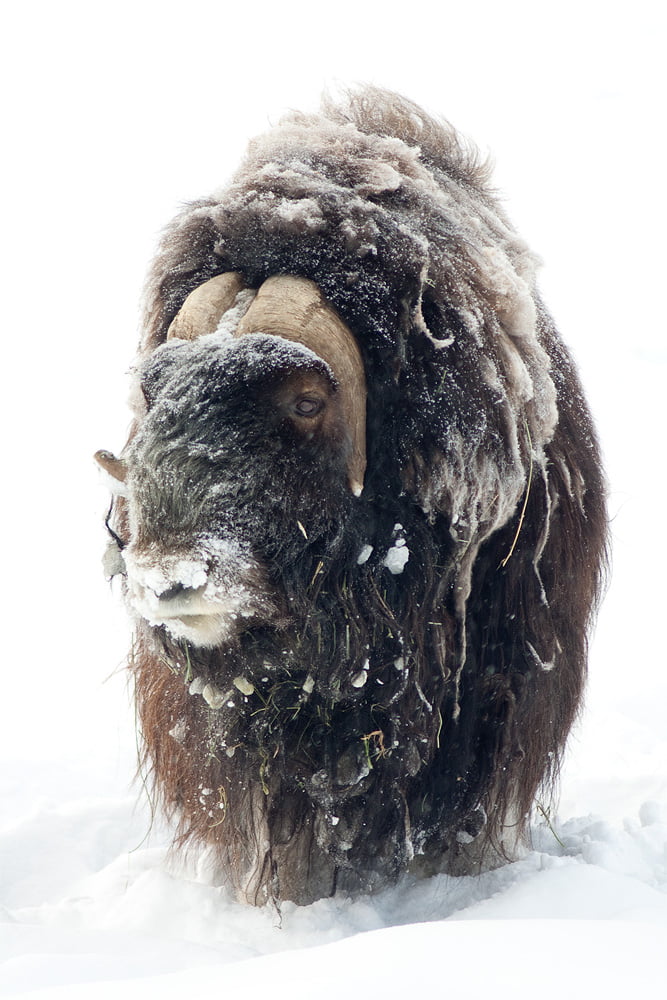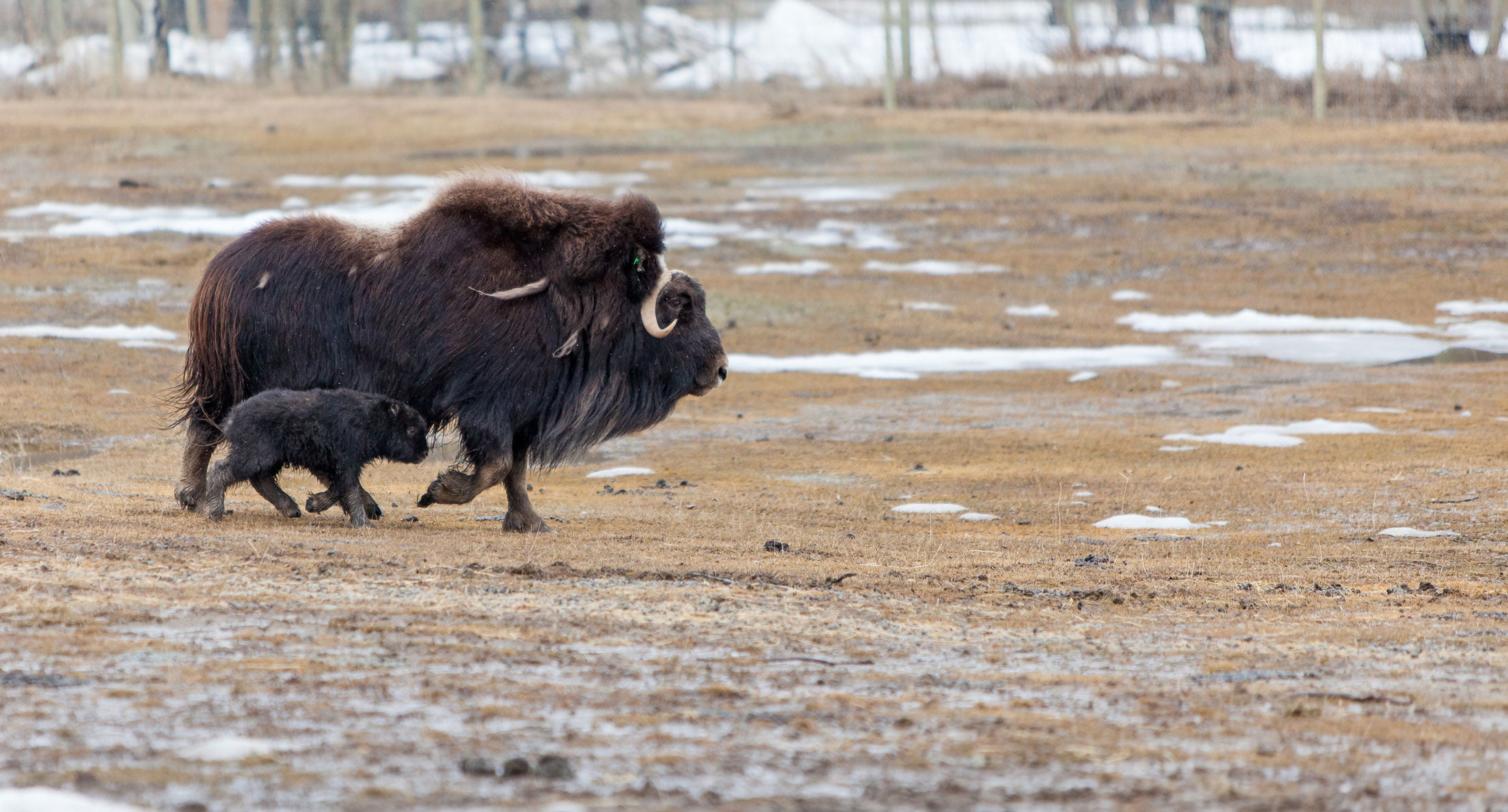
Stay Put – The Muskox Mantra
6 minute read – “Winter Is Here” series continues with the legend of cold climate survivors – Muskox!
Ice age survivor – Oomingmak (Inuit for The Bearded One) is living proof of long-term successful adaptation to a narrow niche – the treeless and blizzard-beaten landscape of the High Arctic Tundra. In the wild, Muskox inhabit parts of the Circumpolar North – Greenland, Alaska, Norway, Russia and Northern Canada – thriving in some of the coldest, longest and darkest parts of the world.
Muskox have evolved to have a stout body posture and short legs to conserve body heat in the winter. Their coat, however, is the most fascinating part within the array of adaptations Muskox possess. While the long guard hair reaches all the way down their legs, like a skirt, to offer protection against wind and snow, their thick undercoat, called qiviut, is really what keeps them alive. Qiviut (kiv’-ee-ute) is warmer than sheep wool and is considered one of the softest and warmest materials on earth (and also among the most expensive). Thanks to the unique make-up and extremely high density of this undercoat, combined with the protection provided by the guard hairs, the cold and wet hardly penetrate all the way to the animals’ skin. The qiviut underlayer is grown every year before winter and in the spring, the animal sheds the dense hair again to avoid overheating during the summer months.


In addition to structural adaptations that are easily visible, the Muskox have a number of behavioural traits and physiological adaptations that help them in their harsh natural environment. For instance, food availability and the severity of weather affects how old a muskox female is for her first breeding cycle and also whether calves are born on an interval of every year or every 2 to 3 years. This results in a low reproductive rate for the species but does lower the stress on an individual muskox so they can breed during a year when conditions are more favourable. From the moment of birth Muskox calves are even prepared to withstand the harsh elements of their new, still winter, world. Born between April and June, their landscape (unlike many of our own that time of year) is still heavily blanketed in snow featuring temperatures well below 0°C. Calves do not tend to take on the stay-put mantra at birth since that could lead to trouble, quickly. Instead, within minutes of birth, calves are mobile miniature woolly mimics of their adult family members, cleaving to their mothers side and her additional protective skirt.

A newborn Muskox calf at the Yukon Wildlife Preserve from 2017 and its mom on the move within minutes of being born.
One behavioural adaptation to the cold is sometimes observed in howling blizzard conditions. Standing stoically in a tight group, Muskox have been able to withstand temperatures up to 70 degrees below zero. Only in the most severe weather will a Muskox lie down with its back to the wind as added protection. Another behavioural adaptation is to be slow moving and to not roam on long migrations like caribou do 1Learn more about Caribou adaptations. This keeps energy output low and allows the large muskox to thrive on low quality food available in their area.
The Arctic Tundra, the only wild home to Muskox, enjoys winter for up to 8 months per year. By September there may be snow on the ground and muskoxen are well equipped with front hooves larger than hind, to dig through wind-blown crusted snow, to get to the food below – grasses, sedges and willows. Muskoxen typically feed in areas where the snow cover is relatively shallow (like valleys). It is usually easy for the Muskox to dig down to the food below, but when the snow crust makes it more challenging, they can lift and drop their head on to the crust to break through to gain access to vegetation.
Where muskox find ways to meet their nutritional needs in a winter-barren landscape their predators, arctic wolves, just the same must test the muskoxen’s formidable stay put mantra. As a survival adaption and anti-predator strategy, fight or flight physiological reaction is important for any prey animal. Many ungulates will choose flight at the sign of threat – fleeing to the protection of forests, like caribou, or to a precipice perfect for only a thinhorn sheep or mountain goat. However, without the protection of any trees; a low variety land form landscape and a dark skyline that merge into one seemingly endless marathon; it’s critical to choose energy conservation, to stay put, and put up a fight through a protective ring. If the Muskox chose flight, it would be less favourable for those calves to keep up to a swiftly moving herd – unless you’re the arctic wolf.
Muskox are built to last – they persevered through an ice age, after all! At the Yukon Wildlife Preserve, which is located in a more southern environment than their natural range, they are applying millennia worth of adaptions even in this niche. Their habitat intentionally faces north, with options for them to take rest in the shade provided by trees of our lower latitude. This further helps preserve a longer snow patch during a typically earlier spring thaw for our muskox, while their more northern and wild cousins still endure weeks to months of true winter. You might see them as dark bumps resting in the snow, apparently doing nothing. Now you know though, they are just doing what they do best – saving energy.

To learn more about Muskox and their unique habitat check out Wildlife Management Advisory Counsil – North Slope
A special animated video sharing this incredible animals Yukon story can be watched here!

Sarah Stuecker
Wildlife Interpreter
As a wilderness guide, Sarah has spent many days out in the bush over the years. Sitting out there glued to the scope is just as fascinating to her as observing and following animal tracks in the depth of winter, trying to draw conclusions of what this particular critter might have been up to. Sarah is passionately sharing her stories as part of our team of wildlife interpreters.

0 Comments